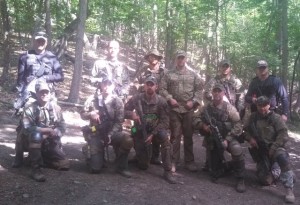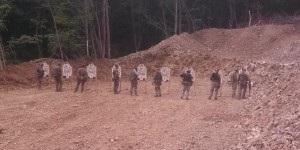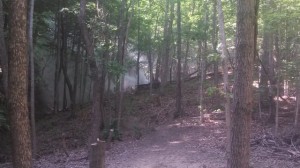Student Review: TC3/RMP/CRCD 30 May – 01 June – Rob
Student Review: TC3/RMP/CRCD by Rob
I drove from Southern Illinois to West Virginia this past weekend to attend Max’s TC3/RMP/CRCD triad of classes. I’m sure glad I did. It was an enjoyable and valuable experience all around.
Here are some of my thoughts and opinions:
Combat Lifesaver (TC3) Class
MVT’s bread and butter is weapons and tactical training, but Max is also a trained combat medic, and it’s a rare and valuable opportunity to be able to piggyback tactical combat casualty care (TC3) with your other tactical training.
Here’s the best way I can explain how valuable the training was to me:
Before TC3 class-> I have tourniquets and an IFAK on my rig because, well, just because it’s the thing to do, and maybe someone around me will know how to use it on me if I’m wounded.
After TC3 class-> I know how and when to use the tourniquets and I’m comfortable that I could at least follow the MARCH protocol and provide the basic critical care to someone with a trauma wound that will help keep them alive until qualified medical personnel arrive.
That’s a huge leap in one half-day class; and a testament to Max’s teaching style, expertise and curriculum.
For those, like me, who have extremely limited medical training and experience, spend some time reviewing Max’s Intro To Tactical Combat Casualty Care (TC3) blog post. In addition, I found Ivy Mike’s “Let’s Talk Trauma” pdf document very helpful (and graphic). Because of the aforementioned limited medical experience, I don’t feel qualified to say much more about the class except to get to the bottom line…
Anyone who is going to be using rifles and pistols in training and real-world situations should have this training. Get this training; one day you, or someone important to you, could be extremely thankful.
Rifle Manipulation Primer (RMP) Class
Think of the RMP class as an invaluable opportunity to get tuned-up and dialed-in prior to the drills and training that CRCD entails. You’ll save time and be better able to focus on the tasks at hand in CRCD (or other tactical training) because you took this class.
Aaron was a very professional, low-key but confident, and competent instructor. He seemed like the best kind of professional NCO that you hope is really out there training and leading the troops. Except in this case, it’s you that’s getting the benefit of his efforts and knowledge.
When I walked off the range after completing RMP, for the first time I knew with certainty (proven by practical tests) that I could quickly and reliably get my rifle back in the fight; no matter what it threw at me. Now that is a high value.
If you already have that kind of certainty, you’ll still get the benefit of both a) additional knowledge, experience and improvements from Aaron and b) an opportunity to prove your certainty.
If you aren’t certain you can quickly and reliably get your rifle back into the fight after a stoppage or malfunction, then I’d suggest that this class is essential for you.
Combat Rifle / Contact Drills (CRCD) Class
How to describe my CRCD experience… Two days of grin-inducing, fun and practical training. And at the end I wished I could stay for a few more days of it!
Max is an exceptional instructor and seems like a genuinely great guy. He’s pretty low key and I only saw him get overly excited once when our particular team was showing early warning signs of introducing randomness on a team drill. He also has that British accent thing going that always seems to slightly bemuse us born on this side of the pond (It was fun to hear his British “mispronunciations”).
The format of all the classes utilized the best aspects of military-style training, without all the worst parts. You get the structure, content and value of military training as paying civilians without the burden of all the organizational overhead (that’s putting it nicely) that can accompany such training when you’re a member of the military.
The crawl -> walk -> run progression was very evident in Max’s CRCD course plan. The instruction, drills and followup all tied together and led from basic individual firing drills on Day 1, progressively towards execution of full team contact drills on Day 2. It was pretty neat to watch and experience.
The live fire ranges were realistic and challenging. I’d personally never seen anything like it.
For me there was a palpable soberness at the start of each non-individual drill: “I’m about to move and fire with other people near me. Think about what I’m doing…I could get someone hurt. Don’t screw it up!” All in all, not a bad gut-check to go through before the drills.
As a bonus, Max had an alumni subject-expert do a lecture and Q&A session with us on the morning of Day 2 while everyone was cycling through the Jungle Walk. F gave an excellent and very informative talk on the subject of NBC (Sorry F, I still have the cold war acronym for CBRN hardwired). I learned a whole lot that morning about some very pertinent and serious topics; quite eye-opening. I hope he does some more blogging/writing about it; it’s that good.
Bottom line: This memorable class was worth every bit of time, energy and money expended. I have a feeling I’ll be back to take it again; maybe combined with the Combat Patrol (CP) class.
Equipment Notes
Mark your magazines for easy retrieval. Looking at pictures from previous classes, I initially resisted putting colored tape on my magazines to make them easy to spot & recover. I thought “How un-tactical is that?” But I observed that in this type of training, where the object is not camouflaged movement, but learning and practicing tactical drills, it makes training go much faster if everyone can retrieve, identify and disburse the group’s magazines from the range (Yes, you will be using multiple magazines of ammo during some drills and will experience some of the stoppages and malfunctions you trained on in RMP. You did take the RMP class, right?) You don’t want to be searching around for your non-marked magazines while everyone else is ready to go to the next training iteration. I had brought some mini crime-scene tape and applied it to my magazines on the first day of CRCD. (Incidently, one of the guys made the comment that the bright green tape he used to mark his magazines during the winter class, was not very visible in the green summer foliage. I think he still has one up there… :)
Buy and bring more magazines. Magazines are inexpensive, and you’re going to want to have a lot of them anyway. For training, it makes things easier and more relaxing if you have enough loaded magazines for a full day’s training. Save loading magazines for after the day’s training. (Just for reference, between my fighting rig and ruck, I had 13 PMags and 2 USGI backup mags loaded for each day.)
Bring more ammo than required if you can. Depending on the group size, there may be opportunities to get additional runs through if you have enough ammo. I expect that you won’t be worried about the cost of the additional ammo out there when you have the opportunity, fully kitted up, to squeeze in a little more training with Max.
Don’t forget to do a quick visual readiness check of your weapon before starting a lane/drill. I started off the first CRCD individual drill of the day on Saturday with my front scope cover still on! (I’m not sure how many people noticed, but Max did.)
Put some combat-rolled duct tape on you or your fighting rig somewhere. At one point out on the lane, the front buckle came off my sling and I was able to quickly make it functional again with the duct tape; all while still on the course.
For what it’s worth: I’ve settled on a chest rig setup as the best for my situation. I personally hate the feeling of having a belt hanging heavy and flopping on my waist and hips like the old LBE did back in my (long ago) Army days. I just have a basic chest rig that I’ve setup with my fighting load. Depending on the situation I’ll throw on a streamlined plate carrier underneath. All I have is steel plates currently, but listening to Max has convinced me to get some lighter weight ceramic plates. (He made me laugh with his line about the sounds of the Liberty Games: bullets hitting steel plates – “ping” :) I also have a hydration carrier I can throw on and clip in to the chest rig for water; it stores at the top of my ruck when I’m not wearing it. I’d rather have my fighting load high, front and tight on me than be hanging low on my waist and butt. I find it frees my lower body and legs up for moving easier and just feels better. Your mileage my vary but this is working well for me and did so for the weekend’s classes.
For what it’s worth II: I’ve set up my tactical apparel so that I can drop my chest rig and knee pads, take off my camo uniform jacket and then be able walk into a grocery store without raising a soccer mom eyebrow (i.e. completely non-camo, non-tactical looking). This seems to me to be the best concept for my situation and location. What that means practically is I’m otherwise wearing civilian non-camo, earth tone work pants & shirt underneath the camo uniform shirt, and an earth tone, non-camo baseball cap. Gloves take care of hand camo and a camo mosquito net over the ball cap breaks up the face and neck when I need too, so I don’t have face camo to worry about. Again, YMMV, but it worked well for me during the classes.
Misc. Notes
Don’t do random during the training. In training like this, it’s probably an instructor’s biggest concern/irritation: People doing random, unexplainable, unexpected things out there on the ranges. This is weapons and basic tactical training; it’s not about individuality and leadership development; that’s for another type of class. For these course you need to take your instructions from the instructor and don’t go beyond them. This is not the time for innovative thinking. You’re learning, training and drilling. I’m happy to report that there was very, very little random activity with our group.
Stay hydrated in general throughout the course (evenings as well). As Max said, if you’re thirsty, you should have already been drinking. As an aside, most of us came back from our iterations on Range 2 coughing. We could never figure out if it was fine dust or some sort of pollen. But be prepared to drink some water after your runs (at least during this time of the year – late Spring/early Summer). Better hydrated equals less physiological stress and less stress equals better learning.
It was interesting to observe the two-day Combat Rifle Manipulation (CRM) class that was held concurrently to our CRCD class. Based on what I saw and heard, this class will be perfect for several people who I’d like to bring along in their tactical training, but have very little weapons experience.
Double-check and evaluate your driving directions. I drove in from the West via US 64 to Romney West Virginia late Thursday night in the rain and fog. Big mistake to take Google Map’s suggestion and cut across rural West Virginia. DO NOT take the 119->33->93->219->93->50 (you get the idea) route suggested across WV. Stay going North on 79 then 68 west and head back south to Romney. Trust me on this one.
Your physical conditioning is as important as you read everywhere (including from Max). I was impressed with the shape everyone in our class was in. I knew I was with a good group of guys when at the end of the class on the last day, I looked over at the pullup bar while waiting to be shuttled out, and there was one of the other 50+ year olds doing chinups!
An Unexpected Takeaway
On the last day, we spent a little time just hanging out and talking with Max between drills (He gave us a nice compliment in his write-up that as a group we were “switched-on” and “in shape”. That actually paid dividends because we had some extra time to just pick his brain on a variety of subjects.)
At one point Max became passionate as he described becoming a legal immigrant to America and what that meant to him. He challenged all of us that were born Americans to stand up and be counted as those who will defend the freedoms we inherited by birth.
I wasn’t expecting it, but after hanging out with Max and my high-quality classmates for the weekend, I left with a new resolve to persevere in the fight for freedom and the republic our forefathers built for us against any and all who would attempt to take it or destroy it.
Last Thoughts
It was a genuine pleasure to meet Max, Aaron and the other alumni. At Max Velocity Tactical, Max has crafted a professional but relaxed environment, with no sign of inflated egos. The training and experience was top-notch, extremely valuable, and worth every dollar spent.
I also appreciated the high quality people in our class. It was an honor to meet and train with all of you. There wasn’t a single “That Guy” in our group, unless it was me. Wait…
—Rob
MVT Forum: @busyguyintville
Somewhere in the Southern Reaches of Occupied Illinois



